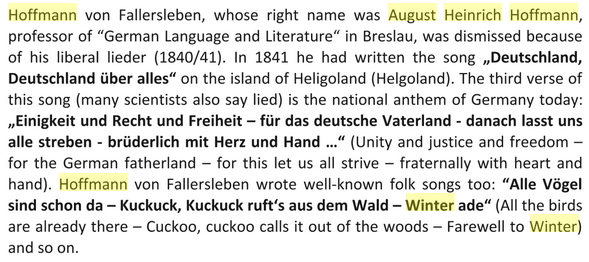*Assignment for "Goodbye to Winter", Solo #15, pg 30.
German Folk Tune
German Folk Tune
August Heinrich Hoffmann, aka Hoffmann von Fallersleben (April 2, 1798 - January 19, 1874)
The folk song "Goodbye To Winter" (Or Winter, Goodbye) has been on of the most popular children's
song for many years. Hoffman von Fallersleben wrote the song in 1835 and assigned it the melody
of the folk song "Schätzchen, ade". Although "Winter, Goodbye!" is mainly popular with children,
the content can also be interpreted politically, because it was created a few years after the Hambacher Fest, and Hoffmann also uses winter in other texts as a metaphor for the political situation in Germany.
Video: (In addition to listening to your CD/iTunes)
(During Atlanta Suzuki Piano Workshop with Karmalita Bawar)
________________________________________________________
 ___1. Study brief info about Germany and be able to find Germany on the globe during your next lesson. Read information about August Heinrich Hoffmann.
___1. Study brief info about Germany and be able to find Germany on the globe during your next lesson. Read information about August Heinrich Hoffmann.  |
| Birth house of Heinrich Hoffmann of Fallersleben (Wikipedia) |
Additional interesting history about Hoffman von Fallersleben:
-Although Fallersleben had not been scientifically trained in music, he composed
melodies for many of his songs, and a considerable number of them are
sung by all classes in every part of Germany.
 |
| Hoffmann von Fallersleben |
-Goodbye to Winter is a spring and children's song written by August Heinrich
Hoffmann von Fallersleben. The text was written in 1835 as Winter's farewell.
[1] It first appeared in 1837 in a two-verse version in Hoffmann's poems, [2]
and in 1843 in a three-verse version together with the melody, [3] a folk song
from the 18th century, which was first recorded in Franconia.
The song was created at the time of restoration
after the Karlovy Vary decisions of 1819. The cuckoo mentioned in the third
stanza may therefore allow a political interpretation: This bird, shot down in
the older song "A Cuckoo Sitting on a Tree", returns a year later the last stanza
back alive. At that time the cuckoo stood for the oppressed and opposed, but
ultimately undefeated bourgeoisie. Accordingly, the winter would stand for the
Karlovy Vary resolutions, which brought about the abolition of freedom of
expression, press censorship and further reprisals. Such a possible reading
played no role at least since the middle of the 19th century, when the song was
recorded in children's song books. [4] Later it was even compulsory teaching
material in the first school year in Prussia. *Wikipedia, under topic "Winter, ade! Scheiden tut weh"
 |
| *Germany before World War I: From Napoleon to the signs of World War I By Egon Harings |
Lyrics to Goodbye to Winter.
 |
| Text and sheet music above from the German Song Garden, 1851 |
-Winter Ade (German Folk Song)
-Winter Ade/Goodbye to Winter (Tolz Boys' Choir)
-Winter Goodbye (Vocal - Lorraine Nelson Wolf)
-Winter Ade/ Goodbye to Winter (Jazz rendition by Michael Schlierf)
-Winter Ade/ Goodbye to Winter (Jazz rendition by Michael Schlierf)
**When you have completed the assignments above and can successfully perform "Goodbye to Winter", you have earned clues to find the Lightly Row Letterbox. Ink and print your beautifully carved stamp into the letterbox journal. There will be a carved stamp in the letterbox to stamp into your Suzuki Book and the letterbox page of your Suzuki notebook. Enjoy one of the treasures surprises left for you in the letterbox!
-------------------------
Letterbox clues: *Ask your teacher




Comments
Post a Comment